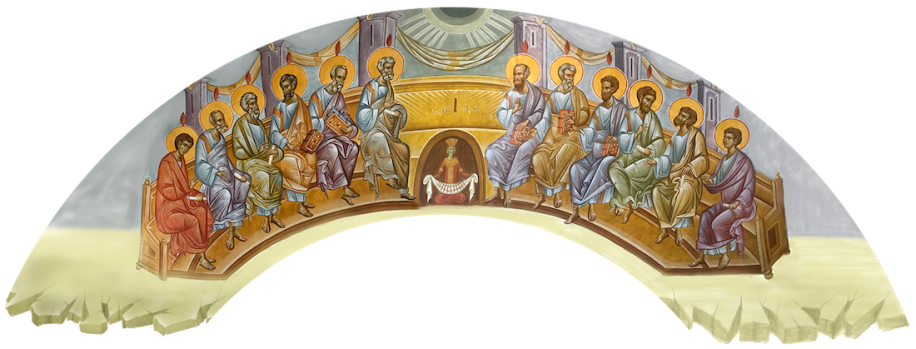The Pentecost

By His Grace Bishop Joachim of Amissos, PhD Bishop Joachim of Amissos is an internationally recognized expert in Byzantine Iconography and is the Director of the Archbishop Iakovos Library at Hellenic College/Holy Cross.
Among the images of the Christological cycle that will appear in the Shrine of Saint Nicholas is that of the Pentecost (ἡ Πεντηκοστή – meaning “fifty”) depicting the event of the Descent of the Holy Spirit in the form of Fiery Tongues upon the Apostles fifty days after Christ’s Resurrection. The Biblical event is recorded in Acts 2 which relates how upon receiving the Holy Spirit, the Apostles began to speak in various languages, proclaiming the salvific message of Christ’s Resurrection to the world, drawing many into the Faith through Baptism and the life of the Church. The Pentecost event had been prophesied already in the Old Testament Book of Joel 2:28-32, “And it shall come to pass afterward, that I will pour out my Spirit upon all flesh…..” This text from the Book of Joel is read at the Great Vespers for the Feast of Pentecost.
The earliest known images of the Pentecost are from the sixth century, appearing in various media, such as manuscripts and pilgrimage art from the Holy Land. The current iconographic presentation, as seen in the icon for the Shrine of Saint Nicholas, was standardized after the end of Iconoclasm (843). The Apostles are represented seated as a group on a curved bench, or synthronon, similar to that found in the apse of an Orthodox church, intended for the bishop and concelebrating clergy. Saints Peter and Paul are found at the center of the group, Peter at the left and Paul at the right, indicating their leadership positions within the apostolic community. The Church refers to them by the Greek term, koryphaioi (the chief, head, or leaders of the Apostles). The Apostles hold either books or scrolls, attributes of their writings and teaching authority. The Divine rays of the Holy Spirit emanate from the arc of Heaven from the center and alight as a “Tongue of Fire” above the head of each Apostle (Acts 2:3). In the lower central niche of the curved synthronon is a crowned figure, personifying the Kosmos (the World) in darkness, but who holds a white cloth with 12 scrolls, the teaching of the Apostles, that overcame darkness and sin with the light of Christ’s salvific message.
The details of the Pentecost icon are not intended to portray an exact, “photographic” record of the events described in the Biblical text of Acts, but rather to offer the icon as an image of the fullness of the Church. The traditional Pentecost icon includes figures that were not one of the original 12 Apostles present on that 50th day after the Resurrection: Saint Paul, as noted above, because he is one of the chief or leaders of the Apostolic community, known by the epithet koryphaios; and the Evangelists Mark (third on the left from the center) and Luke (third on the right from the center). Thus, all four Evangelists appear holding the divinely inspired texts of their Gospels that proclaim the life and teachings of Christ the Lord. They are seated together on the synthronon, the liturgical furniture emblematic of the apse of an Orthodox church sanctuary, as the first hierarchs of the Christian community. The empty place at the center of the synthronon is reserved for Christ, the Head of the Church. Above the central position are the rays of Divine Light, the Grace of the Holy Spirit, the Holy Spirit who is sent from the arc of Heaven by God the Father, and appeared as “Tongues of Fire” on the Apostles. Therefore, the Pentecost icon is also an icon of the Life-Giving Trinity, the Trinity that creates the fullness of the Church.
In the Shrine of Saint Nicholas, the image of the Pentecost will be placed in the highest vaulted area of the west wall of the nave. In this position, it will be directly across from the icon of the Ascension, the two images functioning in an antiphonal, visual dialogue: recalling how at the Lord’s Ascension (forty days after His Resurrection), Christ promised to send His Disciples the Holy Spirit. And now, across the sacred space of the nave, we the faithful behold the fulfillment of that promise, the gift of the Holy Spirit, depicted in the icon of the Pentecost, the icon revealing the source of the Church’s sacred message and work of salvation.